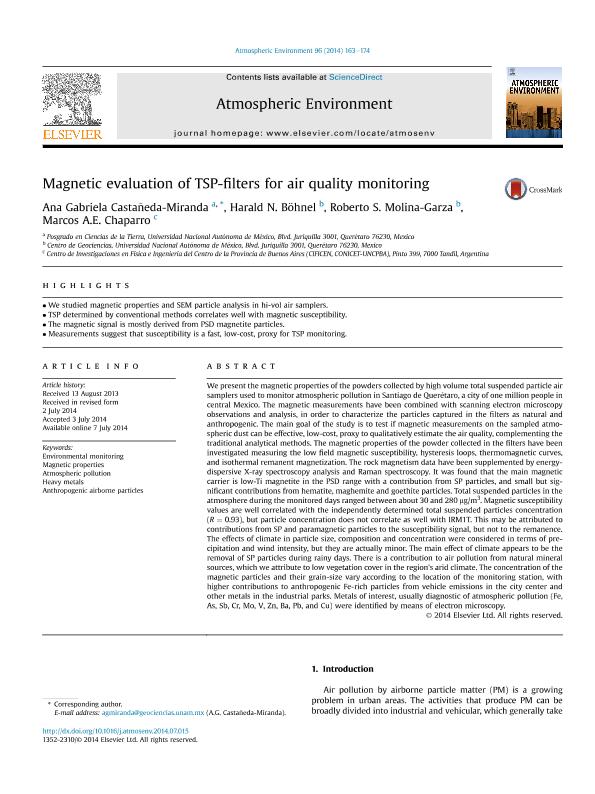Mostrar el registro sencillo del ítem
dc.contributor.author
Castañeda Miranda, Ana G.
dc.contributor.author
Böhnel, Harald N.
dc.contributor.author
Molina Garza, Roberto
dc.contributor.author
Chaparro, Marcos Adrián Eduardo

dc.date.available
2016-03-03T15:41:57Z
dc.date.issued
2014-07
dc.identifier.citation
Castañeda Miranda, Ana G.; Böhnel, Harald N.; Molina Garza, Roberto; Chaparro, Marcos Adrián Eduardo; Magnetic evaluation of TSP-filters for air quality monitoring; Elsevier; Atmospheric Environment; 96; 7-2014; 163-174
dc.identifier.issn
1352-2310
dc.identifier.uri
http://hdl.handle.net/11336/4601
dc.description.abstract
We present the magnetic properties of the powders collected by high volume total suspended particle air samplers used to monitor atmospheric pollution in Santiago de Querétaro, a city of one million people in central Mexico. The magnetic measurements have been combined with scanning electron microscopy observations and analysis, in order to characterize the particles captured in the filters as natural and anthropogenic. The main goal of the study is to test if magnetic measurements on the sampled atmospheric dust can be effective, low-cost, proxy to qualitatively estimate the air quality, complementing the traditional analytical methods. The magnetic properties of the powder collected in the filters have been investigated measuring the low field magnetic susceptibility, hysteresis loops, thermomagnetic curves, and isothermal remanent magnetization. The rock magnetism data have been supplemented by energy-dispersive X-ray spectroscopy analysis and Raman spectroscopy. It was found that the main magnetic carrier is low Ti magnetite in the PSD range with a contribution from SP particles, and small but significant contributions from hematite, maghemite and goethite particles. Total suspended particles in the atmosphere during the monitored days ranged between about 30 and 280 µg/m³. Magnetic susceptibility values are well correlated with the independently determined total suspended particles concentration (R=0.93), but particle concentration does not correlate as well with IRM1T. This may be attributed to contributions from SP and paramagnetic particles to the susceptibility signal, but not to the remanence. The effects of climate in particle size, composition and concentration were considered in terms of precipitation and wind intensity, but they are actually minor. The main effect of climate appears to be the removal of SP particles during rainy days. There is a contribution to air pollution from natural mineral sources, which we attribute to low vegetation cover in the region´s arid climate. The concentration of the magnetic particles and their grain-size vary according to the location of the monitoring station, with higher contributions to anthropogenic Fe-rich particles from vehicle emissions in the city center and other metals in the industrial parks. Metals of interest, usually diagnostic of atmospheric pollution (Fe, As, Sb, Cr, Mo, V, Zn, Ba, Pb, and Cu) were identified by means of electron microscopy.
dc.format
application/pdf
dc.language.iso
eng
dc.publisher
Elsevier

dc.rights
info:eu-repo/semantics/openAccess
dc.rights.uri
https://creativecommons.org/licenses/by-nc-nd/2.5/ar/
dc.subject
Environmental Monitoring
dc.subject
Magnetic Properties
dc.subject
Atmospheric Pollution
dc.subject
Heavy Metals
dc.subject
Anthropogenic Airborne Particles
dc.subject.classification
Ciencias Medioambientales

dc.subject.classification
Ciencias de la Tierra y relacionadas con el Medio Ambiente

dc.subject.classification
CIENCIAS NATURALES Y EXACTAS

dc.title
Magnetic evaluation of TSP-filters for air quality monitoring
dc.type
info:eu-repo/semantics/article
dc.type
info:ar-repo/semantics/artículo
dc.type
info:eu-repo/semantics/publishedVersion
dc.date.updated
2016-03-30 10:35:44.97925-03
dc.journal.volume
96
dc.journal.pagination
163-174
dc.journal.pais
Países Bajos

dc.journal.ciudad
Amsterdam
dc.description.fil
Fil: Castañeda Miranda, Ana G.. Universidad Nacional Autónoma de México; México
dc.description.fil
Fil: Böhnel, Harald N.. Universidad Nacional Autónoma de México. Centro de Geociencias; México
dc.description.fil
Fil: Molina Garza, Roberto. Universidad Nacional Autónoma de México. Centro de Geociencias; México
dc.description.fil
Fil: Chaparro, Marcos Adrián Eduardo. Consejo Nacional de Investigaciones Científicas y Técnicas. Centro Científico Tecnológico Tandil. Centro de Investigaciones en Física e Ingeniería del Centro de la Provincia de Buenos Aires; Argentina
dc.journal.title
Atmospheric Environment

dc.relation.alternativeid
info:eu-repo/semantics/altIdentifier/url/http://dx.doi.org/10.1016/j.atmosenv.2014.07.015
dc.relation.alternativeid
info:eu-repo/semantics/altIdentifier/issn/1352-2310
dc.relation.alternativeid
info:eu-repo/semantics/altIdentifier/url/http://www.sciencedirect.com/science/article/pii/S1352231014005366
Archivos asociados
